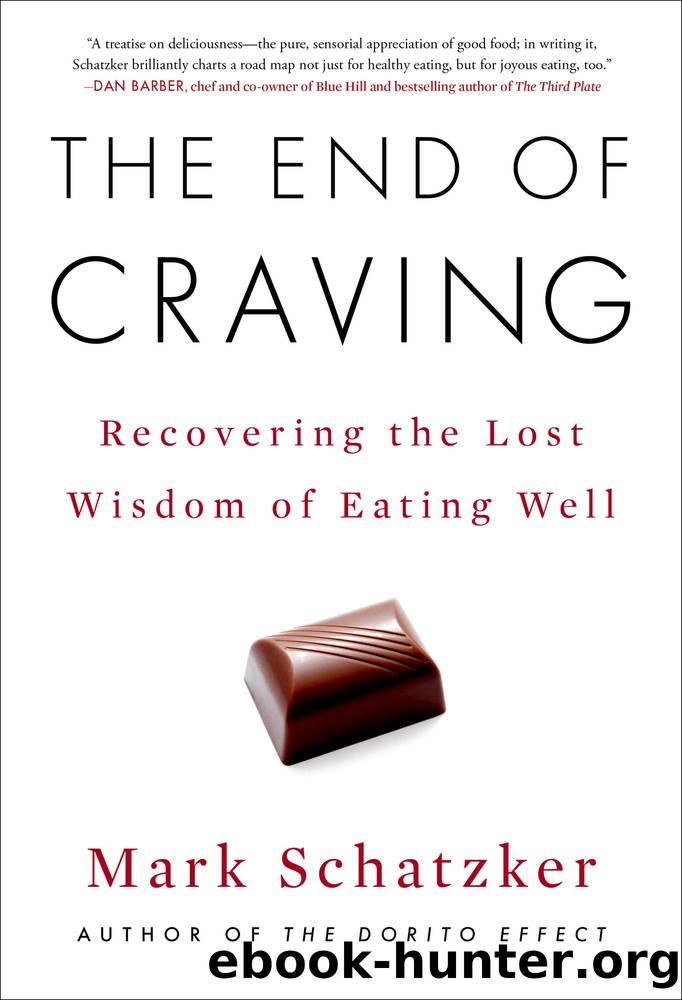The End of Craving by Mark Schatzker

Author:Mark Schatzker
Language: eng
Format: epub
Publisher: Avid Reader Press / Simon & Schuster
Published: 2021-11-09T00:00:00+00:00
10 You Are Eating Pig Feed
If the human appetite can be driven by specific needs, what happens if you stop that need from ever arising in the first place? For example, letâs say you traveled back in time and dispensed vitamin C pills to the thousands of British seamen who were destined to fall ill with scurvy. Would you cure scurvy before it even started?
The answer is an easy yes. Thanks to their replete nutritional status, not only would the sailors have remained in good health, but their yearning for fruits and vegetables never would have awakened in the first place. They could have merrily sailed the ocean blue eating salt beef and hardtack without ever knowing the pain of swollen gums or pitching the bodies of their dead shipmates overboard. Vitamin C pills would have saved lives numbering in the millions.
What would happen if you did the same thing today? If everyone swallowed a vitamin C pill each morning, would this reduce our inclination to eat fruits and vegetables? If so, would these effects take place within days or would they not show up for decades? Would such a shift in eating be good or bad? Maybe if people stopped eating fruit, which has sugar in it (though not much), we would all lose a little weight. Then again, perhaps just the opposite would happen. With the inclination to eat fruits and vegetables satisfied by a pill, people might well eat more of the wrong thingsâmore potato chips, hot dogs, ketchup, and sugary drinks. Then again, maybe nothing would happen at all.
An experiment very much like this one began in 1941, when the American government initiated its policy of encouraging the âenrichmentâ of refined flour with B vitamins, which would go on to effectively become law. Just like that, four micronutrientsâniacin, thiamin, riboflavin, and iron (a mineral)âwere turning up in everyday foods such as white bread, pie, cake, cereal, rice, and grits. For the first time in the history of our species, it was possible to get B vitamins in a food where theyâd never before existedârefined carbs.
The policy wiped out pellagra. But were there side effects? As government policy instruments goes, the enrichment laws, it must be said, were blunt. Only a tiny subpopulation of Americans suffered from pellagra, but the cureâadding B vitamins to flourâapplied to every living American, the vast majority of whom hadnât the slightest need for it. Did fortificationâor âenrichment,â as it is known if the government does itâaffect them? Did all that niacin, thiamin, and riboflavin change the eating behavior of a nation?
One way to explore that question is to examine which foods provided Americans with niacin prior to enrichment. A sizable contribution came from beans, the very food Joseph Goldberger insisted on feeding to sick orphans. Prior to enrichment, the American bean story was a happy one. Bean consumption had steadily been ramping up and reached an all-time high in the early 1940s, at just under ten pounds per person per year. The future, you would think, should have looked rosy.
Download
This site does not store any files on its server. We only index and link to content provided by other sites. Please contact the content providers to delete copyright contents if any and email us, we'll remove relevant links or contents immediately.
Zero to IPO: Over $1 Trillion of Actionable Advice from the World's Most Successful Entrepreneurs by Frederic Kerrest(4069)
Machine Learning at Scale with H2O by Gregory Keys | David Whiting(3648)
Harry Potter and the Goblet Of Fire by J.K. Rowling(3612)
Never by Ken Follett(3537)
Ogilvy on Advertising by David Ogilvy(3345)
Shadow of Night by Deborah Harkness(3178)
The Man Who Died Twice by Richard Osman(2812)
Book of Life by Deborah Harkness(2723)
My Brilliant Friend by Elena Ferrante(2705)
How Proust Can Change Your Life by Alain De Botton(2617)
0041152001443424520 .pdf by Unknown(2603)
Will by Will Smith(2584)
The Tipping Point by Malcolm Gladwell(2563)
How to Pay Zero Taxes, 2018 by Jeff A. Schnepper(2503)
Purple Hibiscus by Chimamanda Ngozi Adichie(2498)
Hooked: A Dark, Contemporary Romance (Never After Series) by Emily McIntire(2426)
Rationality by Steven Pinker(2153)
Borders by unknow(2119)
Daughter of Smoke and Bone by Laini Taylor(2083)
